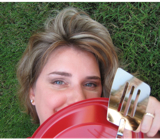Today I bring you another installment from my Jedi master of cooking, Sandy. Check out this post to get the whole story on our journey through Chateaubriand-land.
In this episode, Sandy sends me advice on how to prepare my Chateaubriand stuffed with duxelles.
She didn’t send it by way of Jedi mind tricks — just good ‘ol e-mail.
-Chateaubriand may be split and stuffed with duxelles (a mushroom and herb mixture) before cooking. Finely dice about 1/2 pound of mushrooms, either white or shiitakes or a combination of your favorites. Use a food processor if you want, little pieces are good, just not paste. Finely mince 1 shallot, saute in 1 tablespoon butter in medium skillet until translucent. Add mushroom mixture, 1/2 teaspoon salt and a few grinds of pepper and cook over medium high until the mushrooms give off their liquid and the liquid cooks off and they look dry again. Remove from heat. Add 1-2 chopped herbs, such as Italian parsley if desired. Let cool to room temp. Meanwhile, use a sharp knife to cut a 1 inch slit down the length of the meat. Add the cooled mushroom mixture and roll back into roast shape, tying as necessary.
-Then roast at a high temperature (450) to medium doneness (or less). I would only use olive oil, salt and pepper to season. You may tie rosemary in the trussing string which would give it a little herbal taste. Rare is 125-130. Medium is 140. Use an instant read thermometer or better yet, an electronic (ie the Polder) with the probe stuck in the middle the whole time. After about the first ten minutes, baste the roast with addl olive oil or pan juices if it looks dry. Toss the shallots (if you chose to create a bed of them on the bottom of the pan) to promote even browning. A 2.5 pound roast should take about 30-40 minutes to reach rare doneness.
A duxelles will give your Chateaubriand more texture, interest and flavor. And, man, will your guests be impressed. For more on duxelles, including alternate recipes and uses, check out its Wikipedia description here.
Bon Appetit!

